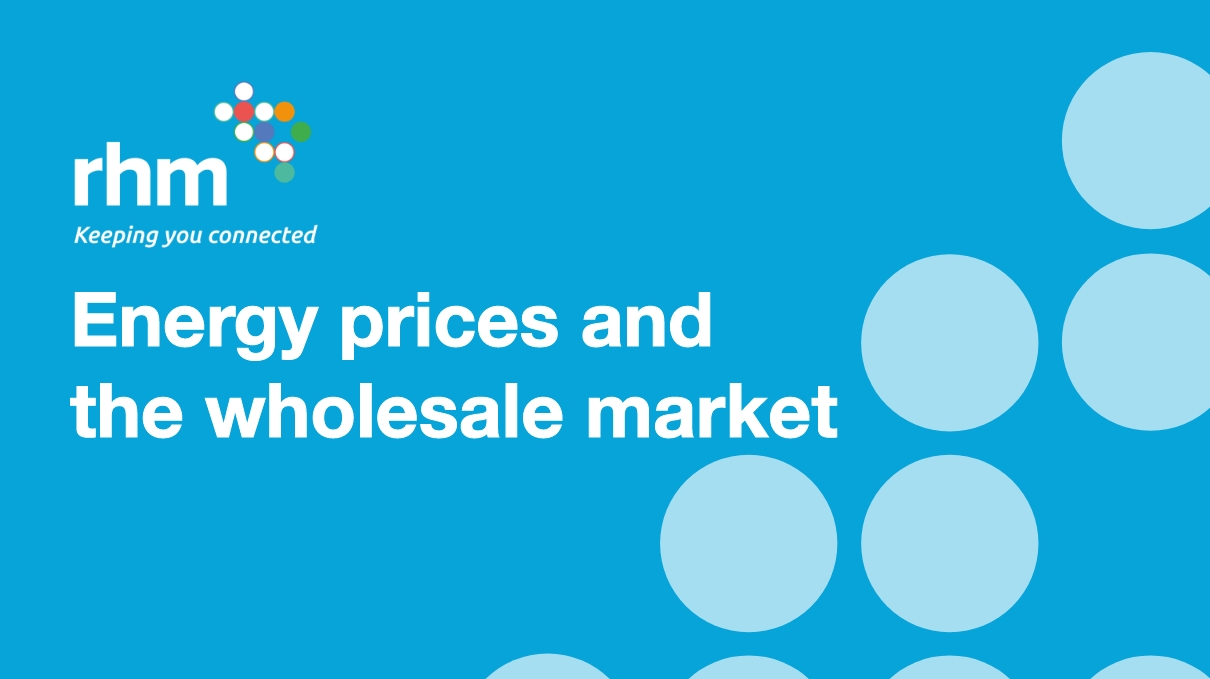
Energy prices have been a major topic of discussion over the last year, which is understandable when we’ve seen bills dramatically increasing from the instability of wholesale market prices. Commercial customers are facing dramatic price increases from a whole mix of factors which contribute to heightened energy prices.
Energy bills are driven on wholesale cost and third-party costs (TPC’s). Pre energy crisis, an energy bill was made up of around 40% wholesale price for an electricity bill and 70% for a gas bill, with the remainder being TPCs which are a combination of costs set by the government, national grid, policy, system costs and electricity transmission and distribution costs. All of which are unpredictable and continually rising.
At RHM, we strive to stay ahead of the changing market trends by monitoring industry shifts. This allows us to guide our clients to make the best decisions with their energy.
In this article we are going to focus on the energy element of a bill, looking at the wholesale market and what is affecting the price of contracts.
During February, there were weeks when the market continued to trade at a lower rate, with wholesale prices hitting the lowest they’d been in the last 15 months.
The Netherlands cut back on consumption, with current levels being the lowest since 1972. This has supported the continent by endeavouring to fill gas levels in a positive step ahead of the next winter season.
The European Commission has been looking at strengthening dealings with US Liquified Natural Gas (LNG) exporters in a move to reinforce the relationships and supply chains with the current largest LNG supplier.
By the 2nd of March, 11 LNG cargoes were set to breach UK shores, but the market is still volatile, with forecasts of China’s energy demands increasing due to the relaxing of their COVID restrictions.
Additionally, the EU used to be able to access cheaper pipeline gas before the Ukrainian invasion (mainly from Russia). Because of the rebound in Chinese LNG imports the EU is constrained in securing gas supplies in 2023.
Bullish pressures indicate prices will rise because of the following:
Bearish pressures indicate prices will fall because of the following:
Extreme weather conditions were seen across the UK and Europe in February, and lower wind speeds slightly raised energy prices.
However, wholesale prices were 17.9% lower than the start of 2023 which is over 80% lower than the peak in December. Gas prices were 26.7% lower than the start of 2023 and 26.9% lower than the peak in December.
Wholesale prices have fallen to the levels we had before the Ukrainian invasion when we had mild weather, renewable generation, and good levels of storage to meet energy consumption demands. Due to this gas and power contracts which are starting now, and in the months and season ahead will currently stay at a similar price.
Due to continued forecasts of energy demands rising, particularly in Asia, Brent crude increased in February. Prices then fell a week later in response to production increases which were related to further concerns over the energy demand in the US.
Prices for Brent are still under $900/bbl. which hasn’t been seen since November and briefly in September. The current price stands at $85.58/bbl.
By 2035, BP have estimated that energy consumption will be 2% lower than it is now because of improved efficiency. Renewable energy looks to be implemented at a quicker rate as a result of the Ukrainian war as well as countries looking to produce energy domestically.
Oil demand is said to decline rapidly after 2030 with world demand dropping to 70 to 80 million barrels a day opposed to 100 million, we currently use.
BP chief economist Spencer Dale has stated: “Global energy polices and discussions in recent years have been focused on the importance of decarbonising the energy system and the transition to net zero.
“The events of the past year have highlighted the complexity and interconnectedness of the global energy system. The increased focus on energy security as a result of the Russia-Ukraine war has the potential to accelerate the energy transition as countries seek to increase access to domestically produced energy, much of which is likely to come from renewables and other non-fossil fuels.
“But the events also show how relatively small disruptions to energy supplies can lead to severe economic and social costs, highlighting the importance that the transition away from hydrocarbons is orderly, such that the demand for hydrocarbons falls in line with available supplies.”
RHM energy transform energy procurement for businesses across the UK. From helping to reduce costs, drive efficiencies and minimise carbon footprints. In the ever-changing energy pricing market, we can make sure you get the best value out of your energy contracts. We continually monitor the fluctuating market to find our partners the best deals and understand there isn’t a ‘one size fits all’ approach.
We offer free, no obligation energy health checks and carbon audits to see if you’re paying what you should be. If you would like to discuss this further, get in contact.
© rhm telecommunications 2024